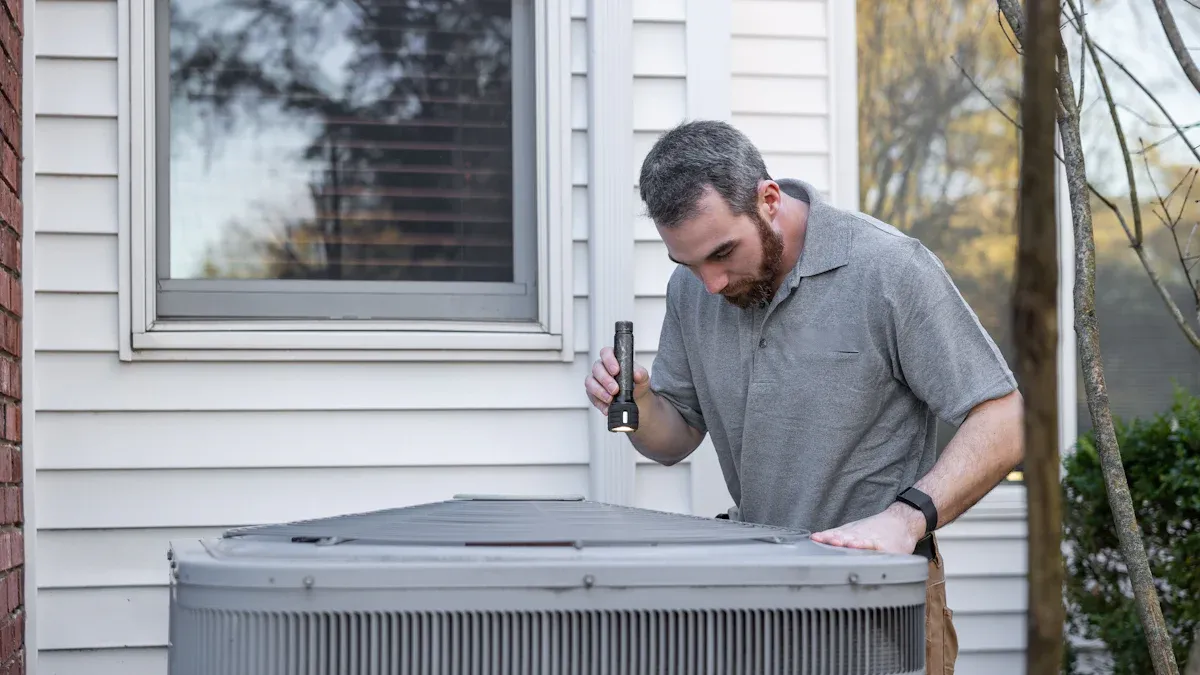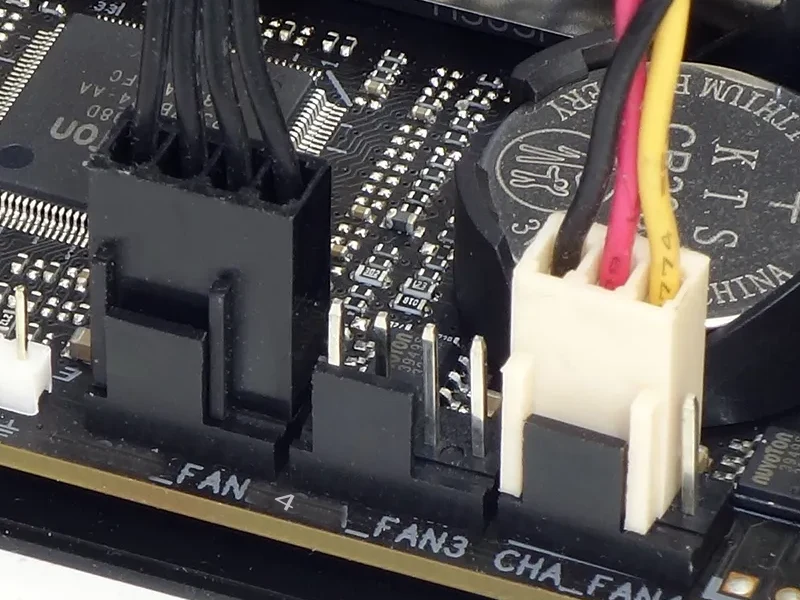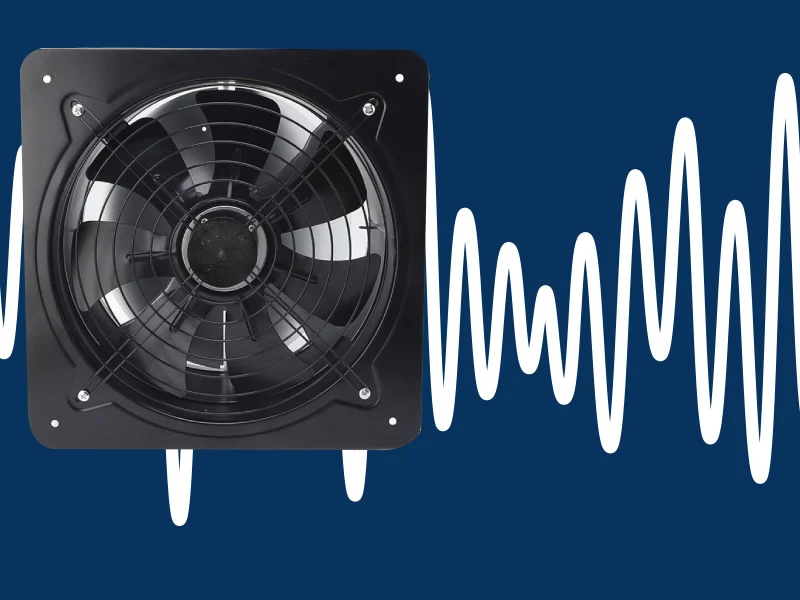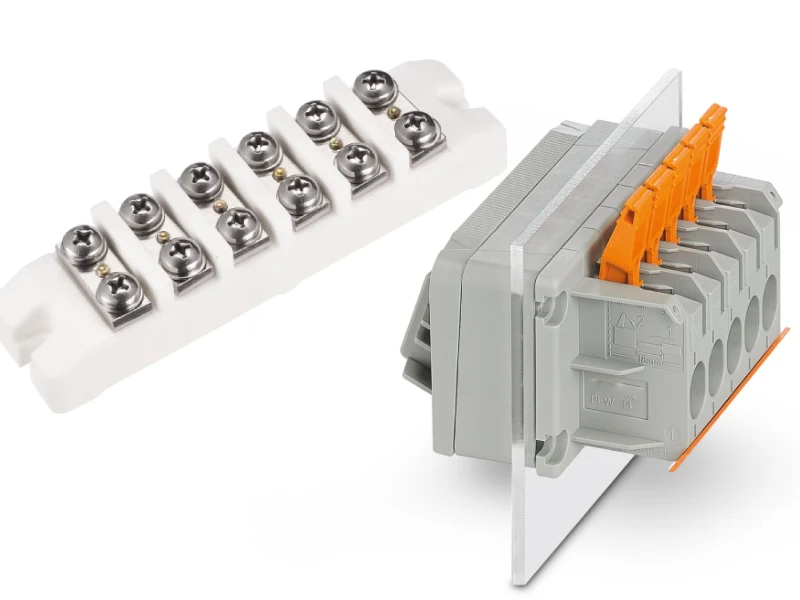You might wonder what is a mechanical air conditioner and why it matters. This system uses mechanical parts to cool air, making your home or workplace comfortable and safe. Did you know air conditioning accounts for almost half of the energy used in homes and about 15% in industries? Reliable cooling keeps sensitive electronics running smoothly, preventing costly breakdowns. With more people living in cities and smart features becoming common, air conditioners play a bigger role than ever in our daily lives.
Key Takeaways
- Mechanical air conditioners cool spaces by moving heat from inside to outside, providing comfort and protecting electronics.
- Regular maintenance is crucial for air conditioners to operate efficiently and extend their lifespan.
- Modern air conditioning systems use advanced features like smart thermostats and eco-friendly refrigerants to save energy and improve performance.
- Understanding the cooling cycle helps you appreciate how air conditioners work to keep your environment comfortable.
- Choosing the right air conditioner type depends on your climate and specific cooling needs, ensuring optimal performance and energy savings.
What Is a Mechanical Air Conditioner
Basic Definition and Concept
You might ask yourself, what is a mechanical air conditioner? This device cools indoor spaces by using mechanical parts to move heat from inside to outside. When you turn on an air conditioner, it pulls warm air from your room, removes the heat, and sends cooler air back. The process relies on a cycle of compression, condensation, and evaporation. You get comfort, safety, and protection for your electronics.
Mechanical air conditioners work in homes, offices, and factories. You see them in places where keeping things cool is important. In homes, they make living spaces comfortable. In factories, they protect machines and sensitive electronics from overheating. Take a look at how these systems are used in different settings:
| Setting | Common Applications |
|---|---|
| Industrial | Heat pumps for heating and cooling, mechanical ventilation with heat recovery, humidification systems |
| Commercial | Systems that improve indoor air quality and ventilation, including heat recovery and mechanical ventilation |
| Residential | Air-source heat pumps for heating, cooling, and domestic hot water |
You might notice that mechanical air conditioners use a mix of moving parts, electrical power, and smart controls. Here’s a quick breakdown:
| Component Type | Description | Functionality |
|---|---|---|
| Mechanical Parts | Includes moving components like fans and compressors. | Responsible for the physical movement of air and refrigerant, essential for cooling operation. |
| Electrical Parts | Powers the mechanical components, can be single-phase or three-phase. | Provides the necessary energy for the mechanical parts to function effectively. |
| Electronic Parts | Advanced controls like remotes and smart systems. | Allows for user interaction and automation of the cooling process, enhancing convenience. |
So, what is a mechanical air conditioner? It’s a system that uses mechanical, electrical, and electronic parts to keep your space cool and safe.
Key Mechanical Features
Let’s dig deeper into what makes a mechanical air conditioner work. You’ll find several key features that set these systems apart. The compressor acts as the heart, pumping refrigerant through the system. Fans move air across coils, helping transfer heat. The coils themselves—condenser and evaporator—play a big role in absorbing and releasing heat.
Modern air conditioning system designs have come a long way. You now get variable-speed compressors, smart thermostats, and eco-friendly refrigerants. These advancements mean you save energy and enjoy better cooling. Here’s a look at some recent improvements:
| Advancement Type | Description |
|---|---|
| Smart Thermostats | Devices that learn user preferences, allow remote control, and provide energy usage reports. |
| Eco-Friendly Refrigerants | New refrigerants like R-32 and R-410A have lower global warming potential and improve efficiency. |
| Energy-Efficient Models | Features like variable-speed compressors and enhanced heat exchangers for better performance. |
| Integration with Home Automation | Allows centralized control and voice command capabilities for enhanced convenience. |
You might wonder how long these systems last. The answer depends on where you use them. In homes, they need regular maintenance to keep running. In factories, they last longer but require more complex care.
| Type of Use | Average Lifespan | Maintenance Needs |
|---|---|---|
| Residential | Shorter lifespan | Regular maintenance can extend lifespan |
| Industrial | Longer lifespan | Complex preventive maintenance required |
Mechanical air conditioners have become much more efficient over the years. New models use less energy and offer better performance. You can see the difference in energy savings and technology:
| Feature | Older HVAC Systems | Modern HVAC Systems |
|---|---|---|
| Operation | Single-stage or two-stage | Variable-speed compressors |
| SEER Ratings | 6 to 10 SEER | Exceeds 20 SEER |
| AFUE Ratings | 60-70% AFUE | Often surpass 95% AFUE |
| Energy Savings | N/A | 20-40% reduction in energy bills |
Tip: Modern air conditioning system designs can help you save up to 60% on energy compared to older models. You get more comfort and lower bills.
You should also think about the environment. Refrigerants used in air conditioners can affect the ozone layer and climate. Many older refrigerants have been phased out because they harm the environment. Newer options are better for the ozone but still need careful handling to avoid global warming risks.
- Refrigerants like CFCs can damage the ozone layer.
- The Montreal Protocols led to the phase-out of harmful refrigerants.
- R-410A is ozone-friendly but has a higher global warming potential.
Mechanical air conditioners must meet strict government standards. These rules push manufacturers to create more efficient and safer systems. You benefit from better indoor air quality and lower emissions.
So, when you ask, what is a mechanical air conditioner, you’re looking at a device that combines mechanical strength, smart controls, and environmental responsibility. You get reliable cooling, energy savings, and peace of mind.
Main Components of Air Conditioners
Compressor and Its Role
You might think of the compressor as the heart of your air conditioner. This part works hard to keep things cool. It draws in cool, low-pressure refrigerant gas and squeezes it until it becomes a hot, high-pressure gas. The compressor creates pressure changes that move the refrigerant through the system. When the refrigerant gets pressurized, it can release heat outside. This process is key for cooling your space. If the compressor fails, your air conditioner stops working. Regular ac maintenance helps keep the compressor running smoothly.
Tip: A healthy compressor means your air conditioner can cool efficiently and save energy.
Condenser and Evaporator Coils
You will find two important coils in every air conditioner: the condenser coil and the evaporator coil. The evaporator coil sits inside your home. It fills with cold refrigerant and absorbs heat from the indoor air. As warm air passes over the coil, the refrigerant turns from liquid to gas, pulling heat out of the air. The condenser coil sits outside. It takes the heat-laden gas from the evaporator and releases the heat into the outdoor air. This cycle keeps your room cool and comfortable.
Here’s a quick look at how these parts work together:
| Component | Role |
|---|---|
| Evaporator Coil | Cools the refrigerant and extracts heat from the air, blowing cool air back into the space. |
| Compressor | Compresses the refrigerant from vapor to liquid, essential for the cooling cycle. |
| Condenser Coil | Removes heat from the refrigerant and releases it to the outside environment. |
| Expansion Valve | Allows refrigerant to expand and cool before entering the evaporator coils. |
Refrigerant and Expansion Valve
The refrigerant is the lifeblood of your air conditioner. It moves through the system, carrying heat away from your space. The expansion valve controls how much refrigerant enters the evaporator coil. When the refrigerant passes through the valve, its pressure drops and its temperature falls. This lets it absorb more heat from the air. If the expansion valve restricts flow too much, your air conditioner loses efficiency. Modern valves adjust the flow based on cooling needs, saving energy and protecting the compressor. Good maintenance keeps the refrigerant level right and prevents leaks.
- Expansion valves reduce refrigerant pressure, making it colder and ready to absorb heat.
- Proper regulation ensures the refrigerant vaporizes fully, protecting the compressor from damage.
- Smart expansion valves adjust flow for efficient operation during different cooling loads.
You can see how each part works together to keep your air conditioner running smoothly. Regular maintenance helps prevent common problems like refrigerant leaks or dirty coils.
How a Mechanical Air Conditioner Works

Cooling Cycle Steps
You might wonder what happens inside your air conditioner when you turn it on. The air conditioning cooling cycle follows a series of steps that keep your space comfortable. Let’s walk through the process together:
- The compressor starts by pumping out high-pressure, superheated refrigerant vapor.
- This vapor moves through a reversing valve, guiding it toward the outdoor coil.
- The vapor travels along the outdoor vapor line and enters the finned outdoor coil. Here, the system removes heat, and the vapor condenses into a high-pressure liquid.
- The warm, high-pressure liquid leaves the outdoor coil and flows through a copper refrigerant liquid line.
- The refrigerant passes through a metering device. This step reduces its pressure and temperature.
- The low-pressure liquid enters the indoor coil. It expands, absorbs heat from the indoor air, and evaporates into a cool vapor.
- The refrigerant vapor heads to the reversing valve and then to the accumulator.
- The accumulator controls the flow of liquid refrigerant and refrigerant oil back to the compressor.
- Finally, the refrigerant vapor flows through the suction line back to the compressor, and the process repeats.
This cycle happens over and over, making sure you get cool air even when the ambient air temperature outside is high. Each step in the process works together to remove heat from your room and send it outside.
Tip: If you keep your air conditioner clean and well-maintained, you help each part of the process run smoothly. That means better cooling and lower energy bills.
Heat Transfer and Air Flow
You might ask, how does your air conditioner actually move heat out and bring cool air in? The process relies on a few key principles: evaporation, compression, condensation, and expansion.
- Evaporation: The refrigerant absorbs heat from the indoor air. As it does this, it evaporates into a gas.
- Compression: The compressor squeezes the gaseous refrigerant, raising its temperature.
- Condensation: The hot, high-pressure gas releases its heat to the outdoor air and condenses back into a liquid.
- Expansion: The liquid refrigerant expands, cooling down before it returns to the evaporator to repeat the process.
Your air conditioner uses several methods to transfer heat and move air:
- Conduction: Heat moves directly from the warm indoor air to the cold evaporator coil.
- Convection: Fans and blowers push air across the coils, circulating it through your room.
- Radiation: Heat can also move through electromagnetic waves, but this plays a smaller role in most air conditioners.
The system relies on fans to keep air moving. These fans pull warm air from your room, push it across the cold evaporator coil, and send cool air back out. The process keeps your space comfortable, no matter how hot it gets outside.
Here’s a quick table to show how each part helps with heat transfer and air flow:
| Mechanism | What It Does | Where It Happens |
|---|---|---|
| Evaporation | Absorbs heat from indoor air | Indoor evaporator coil |
| Compression | Raises refrigerant pressure and temperature | Compressor |
| Condensation | Releases heat to outdoor air | Outdoor condenser coil |
| Expansion | Cools refrigerant before it absorbs heat | Expansion valve/indoor coil |
| Convection | Moves air across coils | Fans and blowers |
| Conduction | Transfers heat between surfaces | Coils and refrigerant lines |
Note: The process works best when you keep filters clean and vents clear. That way, air can flow freely and your air conditioner can cool efficiently.
You can see how every part of the process works together. The system uses science and smart engineering to keep your indoor environment safe and comfortable.
Linkwell Cabinet Air Conditioner Applications
Industrial and Electrical Enclosures
You probably know that keeping electronics cool is a big deal in factories and data centers. When machines run all day, they create a lot of heat. If you let that heat build up, sensitive equipment can fail or even shut down. That’s where a Linkwell cabinet air conditioner comes in. You can use this cooling solution in places like manufacturing plants, data centers, and food processing facilities. It keeps your control panels, PLCs, and robotics at the right temperature, so everything works smoothly.
Here’s a quick look at where you might use these units:
| Application Area | Description |
|---|---|
| Manufacturing | Shields machinery and electronics from heat, dust, and moisture during production. |
| Data Centers | Maintains steady temperatures for servers and networking gear to prevent overheating. |
| Food and Beverage Processing | Controls humidity and temperature, protecting equipment from water sprays and cleaning agents. |
You get peace of mind knowing your equipment stays safe, even in tough environments.
- Protects sensitive electronics in manufacturing.
- Keeps servers cool in data centers.
- Maintains hygiene and temperature in food processing.
Product Features and Benefits
When you choose a Linkwell cabinet air conditioner, you get more than just cooling. You get a system built for reliability and efficiency. These units come with high energy efficiency, so they work well even when temperatures reach 60 ℃. You can monitor and adjust settings easily with advanced digital controls. The IP54 and IP65 protection ratings mean your equipment stays safe from dust and water.
Check out some of the top features and what they mean for you:
| Feature | Benefit |
|---|---|
| High energy efficiency | Cuts down on energy costs, even in hot conditions. |
| Advanced digital controls | Lets you monitor and adjust the unit remotely. |
| IP54/IP65 protection | Guards against dust and water in harsh environments. |
| Condenser management system | Prevents leaks and manages condensation. |
| Compact, lightweight design | Makes installation and maintenance simple. |
| Customizable cooling capacities | Fits different sizes and types of equipment. |
You also get peace of mind with certifications like UL, CE, and ISO. These show that your air conditioner meets strict safety and quality standards. With Linkwell, you protect your investment and keep your operations running without worry.
Comparing Air Conditioners Types
When you look at different types of air conditioner units, you’ll notice each one works in its own way. Let’s break down how mechanical, evaporative, and absorption air conditioners compare, so you can pick the best system for your needs.
Mechanical vs. Evaporative
Mechanical air conditioners use a compressor and refrigerant to cool the air. Evaporative coolers, sometimes called swamp coolers, work by passing air over water-soaked pads. The water evaporates and cools the air before it enters your space.
Here’s a quick table to help you see the main differences:
| Feature | Mechanical Air Conditioners | Evaporative Air Conditioners |
|---|---|---|
| Energy Efficiency | Higher energy use, higher bills | Lower energy use, cheaper to run |
| Cooling Capacity | Works in any climate, precise control | Best in dry climates, less in humidity |
| Initial Cost | More expensive to buy | Lower upfront cost |
| Best Suited For | All climates | Hot, dry areas |
Note: Mechanical air conditioners remove moisture from the air, which helps in humid places. Evaporative coolers add moisture, so they work best where the air is dry.
Mechanical vs. Absorption
You might wonder how absorption air conditioners stack up. Mechanical units run on electricity and use a compressor. Absorption systems use heat—like natural gas or solar energy—to drive the cooling process.
- Mechanical air conditioners give you high performance and lower upfront costs.
- Absorption systems are larger and more complex, but they use less electricity and can be more eco-friendly.
- Absorption units work well where electricity is limited or expensive.
Pros and Cons
Let’s sum up what you get with each type:
- Mechanical Air Conditioners
- 👍 Reliable cooling in any climate
- 👍 Precise temperature control
- 👎 Higher energy use and cost
- Evaporative Air Conditioners
- 👍 Low energy bills
- 👍 Simple maintenance
- 👎 Only works well in dry climates
- Absorption Air Conditioners
- 👍 Uses heat instead of electricity
- 👍 Good for off-grid or eco-friendly setups
- 👎 Larger size and more complex installation
You have many options when it comes to air conditioners. Think about your climate, energy costs, and how much control you want over your indoor environment. The right system can make a big difference in comfort and savings.
You now know how a mechanical air conditioner works and why it matters for your comfort and safety. When you pick a system for industrial or sensitive electronics, keep these points in mind:
| Key Consideration | Explanation |
|---|---|
| Proper Sizing | Ensures the system is neither too small (overworking) nor too large (poor air quality). |
| Professional Consultation | Engaging certified contractors ensures accurate load calculations and system selection. |
| Air Quality and Energy Efficiency | Essential for maintaining product integrity and compliance with industry standards. |
| Compliance with Standards | Adhering to OSHA and other regulations is crucial for safety and operational integrity. |
| Customized Solutions | Tailored systems can integrate advanced controls and monitoring for optimal performance. |
Regular ac maintenance keeps everything running smoothly. Linkwell Cabinet Air Conditioners help protect your equipment by keeping temperatures stable and blocking dust and moisture. You get peace of mind and longer-lasting electronics.
FAQ
How often should you clean your air conditioner?
You should clean your air conditioner’s filters every month during heavy use. If you see dust or notice less airflow, it’s time for a quick clean. Regular cleaning helps your system run better and last longer.
Can you install a cabinet air conditioner yourself?
You can install some models if you follow the instructions and have basic tools. For larger or more complex units, you should call a professional. This keeps your system safe and working right.
What size cabinet air conditioner do you need?
You need to match the cooling capacity to your enclosure’s size and heat load. Check the manufacturer’s guide or use an online calculator. Picking the right size keeps your equipment cool and avoids wasting energy.
Why does your air conditioner freeze up?
Your air conditioner can freeze up if airflow gets blocked or refrigerant runs low. Dirty filters or coils often cause this. If you see ice, turn off the system and check for clogs or call a technician.
How do you know if your system needs maintenance?
Look for signs like strange noises, weak airflow, or higher energy bills. If your system doesn’t cool as well as before, it’s time for a checkup. Regular maintenance keeps everything running smoothly.




